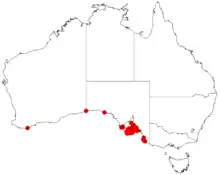| Scaevola angustata | |
|---|---|
| Scientific classification | |
| Kingdom: | Plantae |
| Clade: | Tracheophytes |
| Clade: | Angiosperms |
| Clade: | Eudicots |
| Clade: | Asterids |
| Order: | Asterales |
| Family: | Goodeniaceae |
| Genus: | Scaevola |
| Species: | S. angustata |
| Binomial name | |
| Scaevola angustata Carolin[1] | |
 | |
| Distribution map | |
Scaevola angustata is a species of flowering plant belonging to the family Goodeniaceae. It has pale blue to purple flowers and is endemic to South Australia.
Description
Scaevola angustata is a shrub with ascending or horizontal stems, up to 1 m (3 ft 3 in) high, glabrous, and sticky when young. The leaves are elliptic to oblong-lance shaped, 2–10 cm (0.79–3.94 in) long, 2–40 mm (0.079–1.575 in) wide, margins toothed and sessile. The flowers are in terminal spikes up to 9.5 cm (3.7 in) long, bracts 5–24 mm (0.20–0.94 in) long and linear shaped. The corolla 11–20 mm (0.43–0.79 in) long, mostly sticky and smooth on the outer surface, light blue or purple, and the wings 1 mm (0.039 in) wide. Flowering occurs mostly from August to November and the fruit is broadly egg-shaped, up to 4 mm (0.16 in) long, warty to wrinkled, more or less ribbed, glabrous or with occasional hairs.[2][3]
Taxonomy and naming
Scaevola angustata was first formally described in 1986 by Roger Charles Carolin and the description was published in Flora of South Australia.[4] The specific epithet (angustata) means "narrowed".[5]
Distribution and habitat
This species of scaevola grows on limestone, sand dunes and heath near the coast of south-eastern South Australia.[2]
References
- ↑ "Scaevola angustata". Australian Plant Census. Retrieved 6 February 2022.
- 1 2 Carolin, R.C. "Scaevola angustata". eFloraSA-Electronic Flora of South Australia. State Herbarium of South Australia. Retrieved 7 February 2022.
- ↑ Carolin, R.C. "Scaevola angustata". Flora of Australia. Australian Biological Resources Study, Department of Agriculture, Water and the Environment Canberra. Retrieved 7 February 2022.
- ↑ "Scaevola angustata". Australian Plant Name Index. Retrieved 9 February 2022.
- ↑ Sharr, Francis Aubi; George, Alex (2019). Western Australian Plant Names and Their Meanings (3rd ed.). Kardinya, WA: Four Gables Press. p. 133. ISBN 9780958034180.